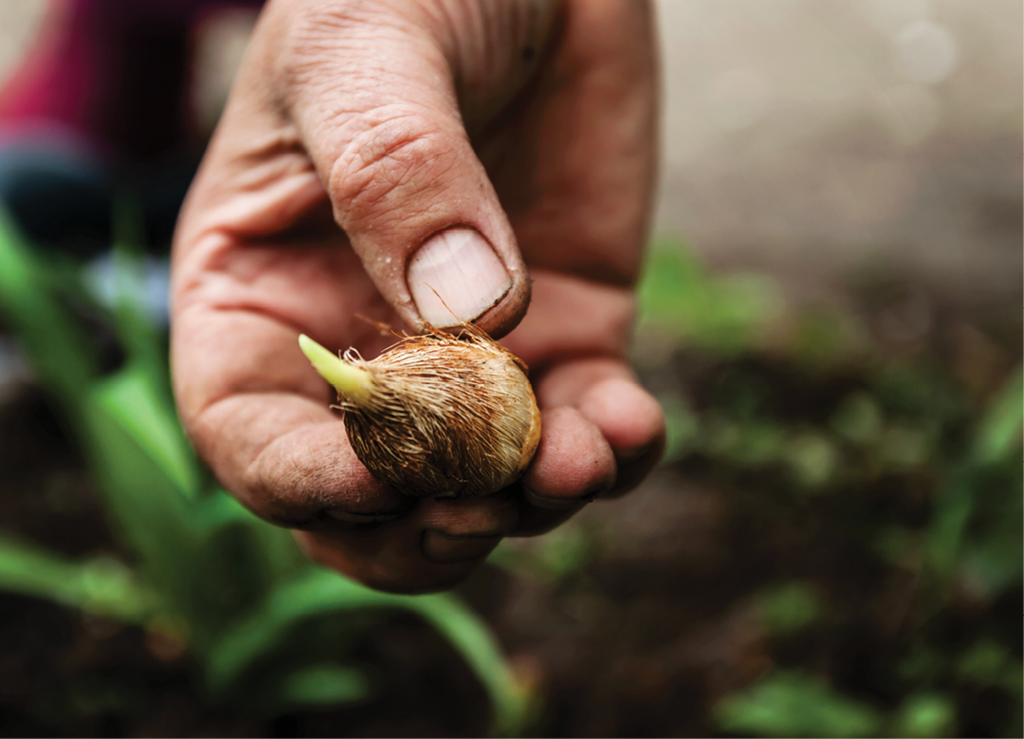

Today’s garden consumers are hungry for the latest and the best, whether that’s hot new hydrangeas or Instagram-worthy annuals. So, it should be no surprise that appetites for something new extend to bulbs and seeds. Expert insights on bulb and seed trends headed your way can help you inject excitement — and sales — into both categories.
Take bulbs to the next level

Ask third-generation bulb grower Brent Heath about bulbs and a world of possibilities opens up. Co-owner of Brent and Becky’s Bulbs, located in Virginia’s Chesapeake Bay region, Heath is a breeder, supplier, consultant and educator rolled into one. A sought-after speaker who’s shared his passion at venues in every state except North Dakota and Hawaii, he keeps his finger on the best of tradition and the latest bulb trends.
As Heath points out, “Anyone can have a yellow daffodil.” But capitalizing on distinct trends in bulbs — “bulbs” being bulbs, corms, tubers, rhizomes and tuberous roots — that go beyond the basics of flower type, color and bloom time can set your IGC apart.
Heath suggests asking your bulb supplier for bulb varieties that embody the in-demand, added-value traits of these leading bulb trends:
- shorter stature with more compact growth,
- attractive foliage, such as darker, narrower leaves,
- pleasing fragrances,
- increased flowers, both in number of bloom stalks and blooms per stalk,
- strong stems that hold flowers above foliage,
- longer-lasting blooms,
- improved disease resistance (primarily to fusarium,)
- anything significantly different in appearance.
The trend toward compact bulb varieties is significant, but Heath predicts an emphasis on leaves by bulb breeders, including himself. “We all understand now that leaves are solar collectors. They need to stay in place at least eight weeks after the bloom, but big, wide leaves are very unattractive,” Heath says.
“Narrow leaves are much easier to mask with companion plants.”
Making the most of new trends starts with helping customers recognize desirable features and expand their vision for gardening with bulbs. Some areas Heath recommends for educational opportunities and fresh selling strategies include:
Companion plantings – “Teach people how to integrate bulbs into the fabric of the garden along with their other plants,” Heath says. This is Heath’s most requested lecture topic.
Container plantings – Heath’s second-most popular lecture and workshop, entitled “Living Flower Arrangements,” teaches how to create mixed containers with layers of bulbs. Introduce your customers to bulb varieties well-suited to container growing. New compact varieties fit this option well.
Pollinator plants – Daffodils aren’t big draws to native pollinators, but many other bulbs are, including tulips, lilies and dahlias. “Dahlias are great for butterflies, particularly in the fall migration when dahlias are at their peak,” Heath notes.
Potted bulbs – “Teach customers to fill empty garden spots in spring with potted bulbs. We don’t use nearly enough potted bulbs in this country,” Heath says.
As final tips, Heath advises IGCs to press bulb suppliers for high-quality cultivars suited to their specific regions that will differentiate them from box stores. Retailers can then educate their customers on the differences. And, timing is important.
“Garden center space is being lost to Christmas, which is a real thorn in the side for the bulb industry,” Heath explains. Bulbs dug prematurely to satisfy retailers — and planted in warm soil — can spell failure for bulb gardeners. “October and November are prime months for selling bulbs. Don’t rush them.”



Seeds: the “foodie” influence
Maine-based Johnny’s Selected Seeds is a favorite seed source for small- to medium-scale market gardeners — those growers filling farmers markets and restaurant kitchens with the latest edible delights. Food trends that send consumers to your IGC in search of exciting new seed varieties often start with the growers that Johnny’s serves.
Part of the job for Pete Zuck, Johnny’s vegetables product manager, is staying ahead of the game so that growers and cutting-edge chefs have the varieties they want and need. The rise of “foodie” culture tops Zuck’s list of industry-influencing trends.
“There’s this hierarchy of trends now. At the top is the foodie culture, this connoisseur culture. We saw it happen with beer, wine and cocktails,” Zuck explains. “There are all these opportunities for new vegetables to catch on. Kale is the ultimate example.”
In Zuck’s hierarchy, the foodie culture feeds the next level, the local food movement and a push for better flavor in existing crops.
“Flavor is something that’s been kind of neglected for a long time,” he says. “That’s turning around now.”
With foodie culture as the connecting thread between seed companies, market growers, chefs, consumers and you, items on Zuck’s trend list can help your seed sales keep up with the curve:

MICROGREENS
Chefs and growers love this quick turnaround crop that IGC customers can grow indoors year-round. Kale and kohlrabi are favorites.

BABY LEAF LETTUCES
Baby varieties of leafy greens, such as baby lettuces, kale, Swiss chard and beets, are booming.
BRUSSELS SPROUTS
Farmers market shoppers love the on-the-stalk look. They’ll want to give it a shot in home gardens, too.
RADISHES
Exotic, colorful varieties are top-sellers.

SUPER-HOT PEPPERS
More heat, more flavor says it all.
SMALL-FRUITED TOMATOES
Demand is up for grape and cherry tomatoes with exotic looks and distinctive flavor profiles.
Non-traditional colors
Think purple, with a qualifier. “Customers gravitate toward color, but non-traditional color varieties tend to have trade-offs, like flavor,” Zuck says. Consumers want seed varieties with outstanding color and flavor, such as Bacchus radish, a rich, deep purple variety.
“IMITATION HEIRLOOM” TOMATOES
High-end tomato breeders are using heirloom bloodlines to create tomatoes with heirloom look, flavor and eating quality, but with modern disease resistance, productivity and uniformity. Zuck predicts a flood of “imitation heirlooms” over the next five to 10 years. The challenge will be finding varieties that live up to the goal.

ANYTHING FOR FREMENTATION
Kimchi, the spicy fermented Korean side dish, is creating demand for Chinese cabbage, daikon radishes and fermentable veggies.
CUT FLOWERS
Take heed. “Locally sourced flowers are becoming a big thing for market growers. That’s our fastest growing segment right now,” Zuck says.
ORGANIC AND NON-GMO SEED
Demand for organic seed varieties and non-GMO seed is growing. (Johnny’s sells organic and conventional seed, all non-GMO.)
Follow market gardener trends and create collections of seed packets to mimic fresh market displays. For example, go beyond single mixed packets and combine packs of leading radish varieties in red, white, pink and purple. Follow suit with colorful seed collections of the latest carrots, beets or leafy greens. Do the same with seeds for exceptional cut flower varieties to help gardeners envision bouquets. And don’t forget to include seed packets in your cutting garden displays.

With collaborations between breeders, growers and chefs fueling the seed industry, Zuck expects obscure vegetables to jump to the forefront of seed sales. “For seed companies, our big thing is trying to figure out what’s the next kale,” he says.
So, what’ll it be? “Chicory is sort of on the cusp of being a breakout thing,” Zuck says. “It has this interesting flavor profile, the bitterness.” The popularity of Negronis, an Italian cocktail with a bitter complexity, and other signs show bitterness catching on. “Our chicory breeder, John Navazio, has this expression, ‘Bitter is the new sour,’” he says, with a laugh. “Chicory is kind of satisfying that new flavor niche and the grower niche as well.”
Will all these trends in bulbs and seeds trickle down to your IGC? Time will tell. But in the meantime, it can’t hurt to keep an eye on chicory varieties and narrow-leaved daffodils as well.

Explore the August 2018 Issue
Check out more from this issue and find your next story to read.
Latest from Garden Center
- GS1 US Celebrates 50-Year Barcode 'Scanniversary' and Heralds Next-Generation Barcode to Support Modern Commerce
- Weekend Reading 7/26/24
- Retail Revival: Making gardening contagious
- ‘Part of our story’
- Registration now open for Garden Center Fertile Ground Webinar Series
- Dramm introduces new hose, sprinkler attachments for home gardeners, nurseries
- Meet the 15 Retailers' Choice Awards winners from Cultivate'24
- 2024 Top 100 Independent Garden Centers List





